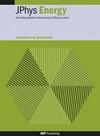汽车PEMFC堆中局部反应物缺乏下电耦合电池的相互作用现象
IF 6.3
3区 材料科学
Q1 ENERGY & FUELS
引用次数: 0
摘要
聚合物电解质膜燃料电池(PEMFCs)的局部电流密度分布会受到各种误差状态的扭曲。电流密度分布(cdd)的差异,相邻电池的堆叠是平衡的平面内电流在夹心双极板。因此,会产生诸如局部电池电压和电流密度最大值的有害差异等退化应力源。因此,开发了一种新的方法,通过将局部人工饥饿集成到组件中的一个燃料电池中来有意地操纵CDD剖面。该技术已应用于汽车尺寸的PEMFCs单电池和20电池短堆中,以分析这种电压和电流的再分布现象。仅在堆叠中观察到局部电池电压的剧烈畸变,这是通过补充模拟来解释的。因此,将CDD测量与空间分辨极化曲线模型相结合,计算了电耦合燃料电池的局部电压分布。在此基础上讨论了多点电池电压监测测量装置的性能和局限性。通过检测这两种独立在线测量技术之间的相关性,可以在汽车尺寸的PEMFC堆叠运行过程中以相当高的精度定位这些误差状态。本文章由计算机程序翻译,如有差异,请以英文原文为准。
Interaction phenomena of electrically coupled cells under local reactant starvation in automotive PEMFC stacks
The local current density distribution of polymer electrolyte membrane fuel cells (PEMFCs) can be distorted by various error states. Differences in current density distributions (CDDs) of adjacent cells in a stack are equilibrized by in-plane currents within the sandwiched bipolar plates. Degradation stressors such as detrimental differences in local cell voltage and current density maxima can thus be generated. A novel method was therefore developed to intentionally manipulate CDD profiles by integrating local artificial starvation into only one fuel cell in an assembly. This technique is applied to automotive-sized PEMFCs single cells as well as in 20 cell short-stack to analyze such voltage and current redistribution phenomena. A drastic distortion of local cell voltage is only observed for stacks, which is explained by a supplementary simulation. The local voltage distribution of an electrically coupled fuel cell is therefore calculated by combining CDD measurements with a spatially resolved polarization curve model. The capabilities and limits of a multipoint cell voltage monitoring measurement device are discussed on this basis. The inspected correlation between these two independent online measurement techniques allows to localize such error states with considerable accuracy during operation of automotive sized PEMFC stacks.
求助全文
通过发布文献求助,成功后即可免费获取论文全文。
去求助
来源期刊

Journal of Physics-Energy
Multiple-
CiteScore
10.90
自引率
1.40%
发文量
58
期刊介绍:
The Journal of Physics-Energy is an interdisciplinary and fully open-access publication dedicated to setting the agenda for the identification and dissemination of the most exciting and significant advancements in all realms of energy-related research. Committed to the principles of open science, JPhys Energy is designed to maximize the exchange of knowledge between both established and emerging communities, thereby fostering a collaborative and inclusive environment for the advancement of energy research.
 求助内容:
求助内容: 应助结果提醒方式:
应助结果提醒方式:


